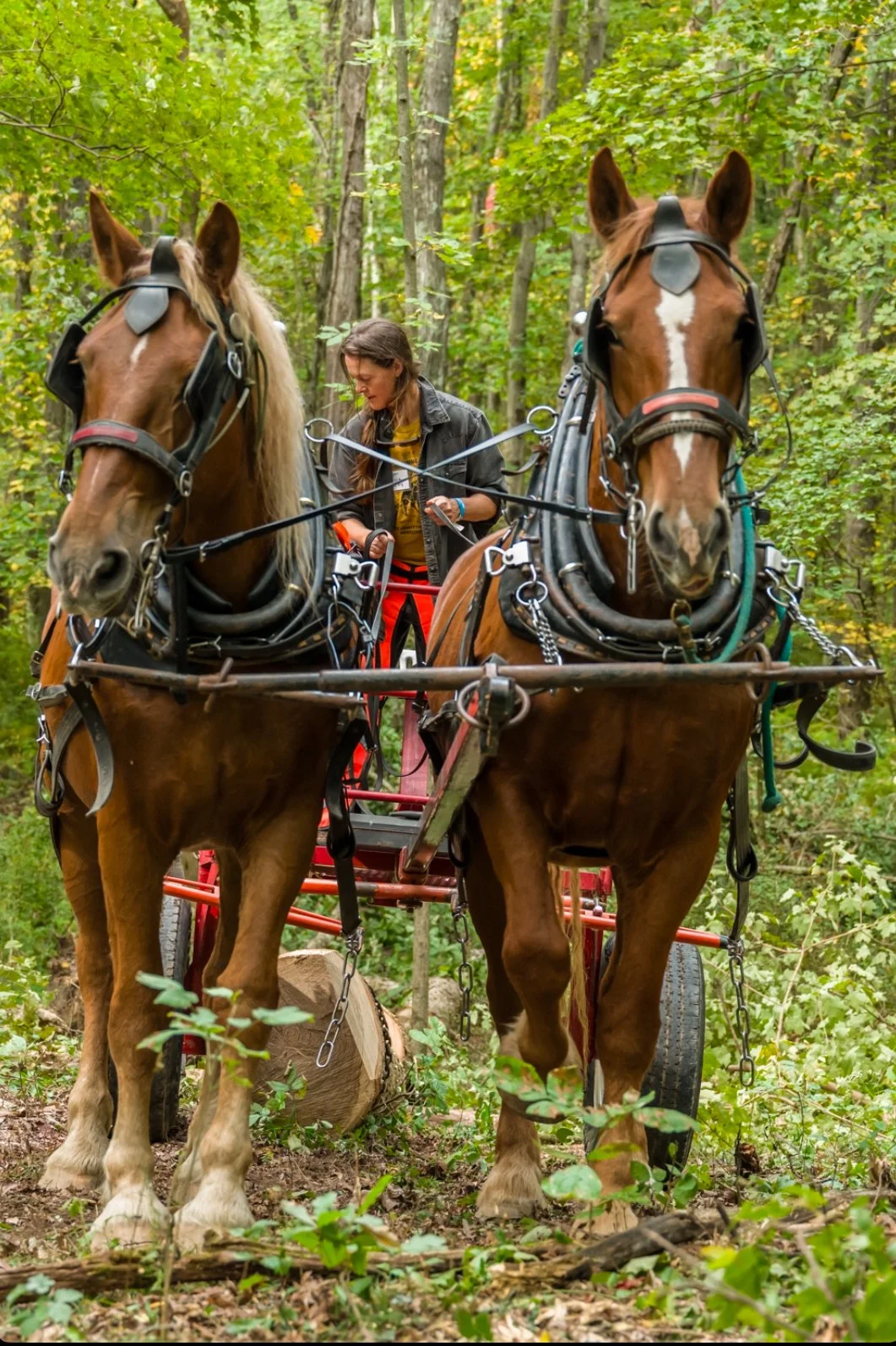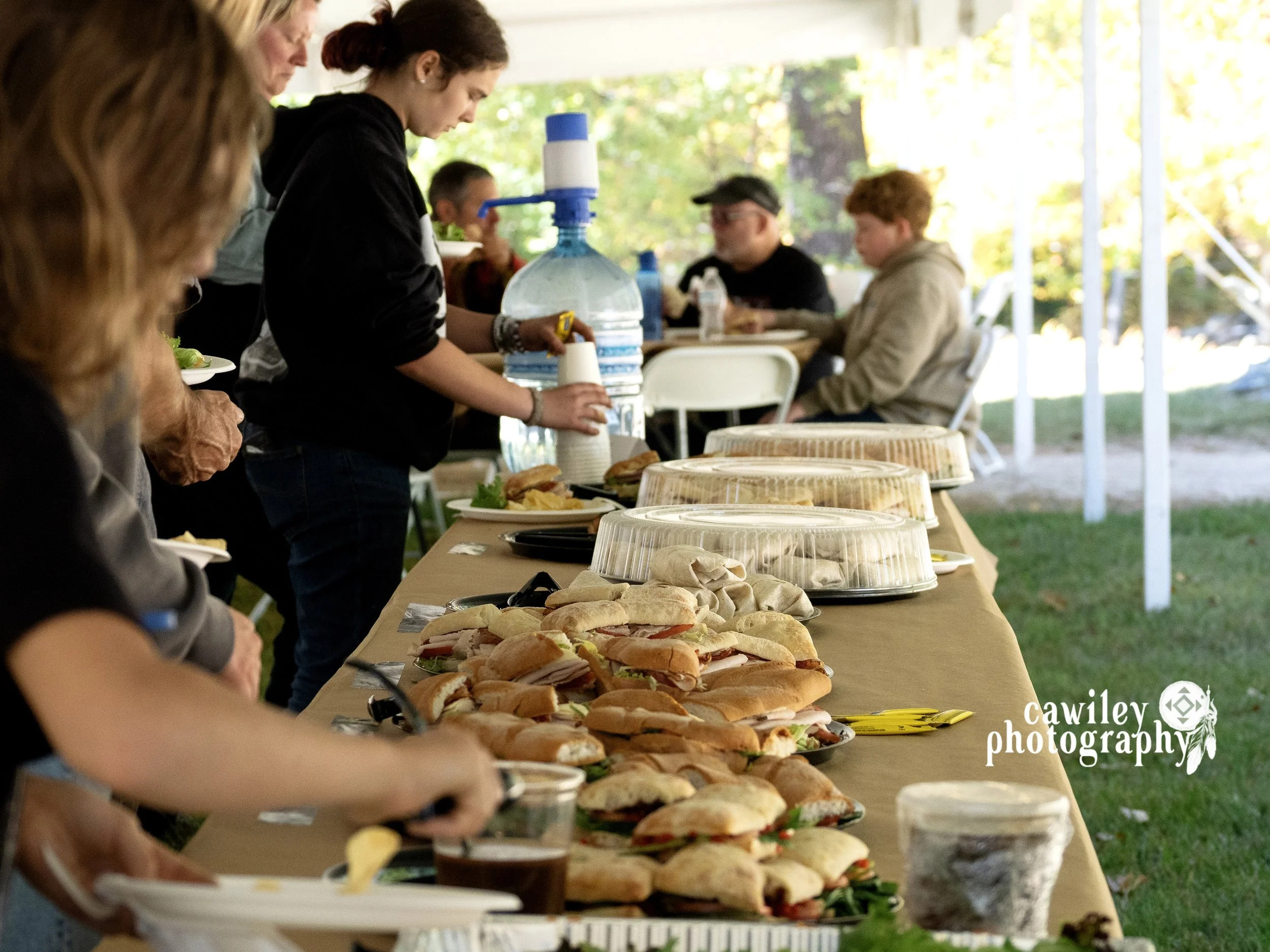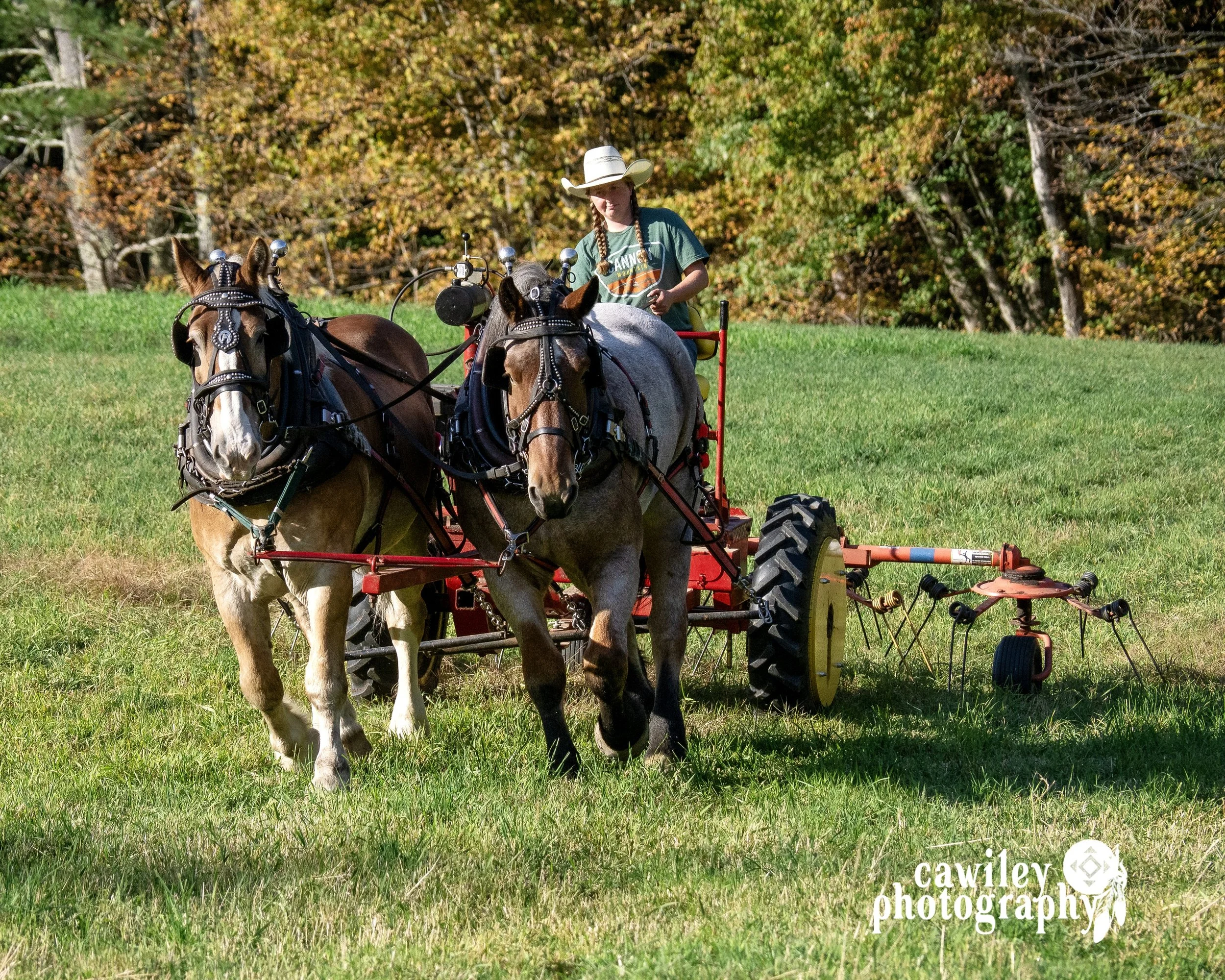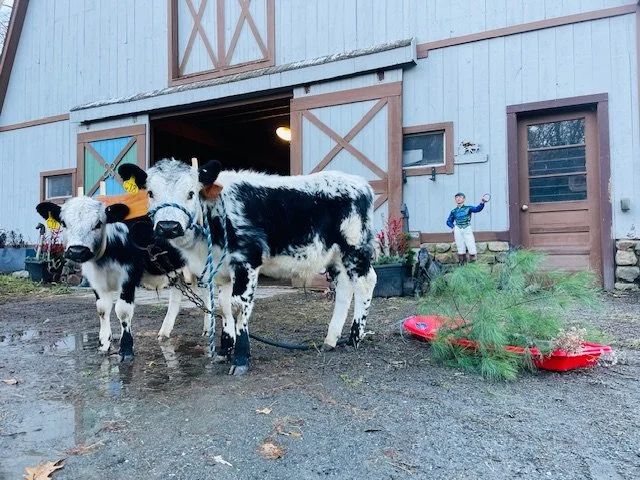Jump to Event Calendar
Current Newsletter
Vol 15, Number 9, October 2025
Welcome
Dear Newsletter readers,
When I first wanted to learn to work horses, I did not know how to begin. I was shy, with no experience, and as a single woman in what looked like a male-dominated world, I was not sure I would be welcome. Then I stumbled across DAPNet. The forum and the field days opened a door. The people on the inside held it wide, as if they had been waiting for me all along.
I’m not going to lie, I spent a lot of admin time on the board making friends, but once I got to know folks their generosity was boundless: Marco and Donn gave me hours of patient instruction. Jason Connelly, my neighbor, gave me needed hours with his team tedding hay and giving sleigh rides. Jared loaned me Bright and Belle, and with them his cowboy wisdom. Tim Biello sent me home with a harness to use while I figured out whether or not I could handle my own team. Erika and Sarah offered refinement, and answered the questions I was too embarrassed to voice elsewhere. Erika even bought me lines for my birthday and has kept me in equipment ever since, enough to put my distillery garden in the ground and help neighbors plant up and down the Charlotte Valley. When Jake and Abby, horses I had only ever read about in my early farming days, needed a new home, the circle pointed me toward them. Derek and John sold me their log arch to get me moving in the woods. Marielle, my amazing farrier has been very generous with her lessons, and now I do most of my own work. At last year’s Field Days, Ian pressed a pair of grabs into my hand, a gift I did not know I had been waiting for. Little welcome-to-the-fold moment.
Field Days Gallery
A few snapshots of the weekend that we've been treasuring. Our communications committee is hard at work on a Commemorative Book with photos of the weekend - stay tuned for more details about that!
Ledge Spring Farm
Entering the World of Ox Power
By Ari Auger
The Draft Animal Power Network's Oxen Basics intensive: the little push I needed (or wanted) to buy my first pair of bull calves. I had been fascinated with oxen for quite some time; enamored by them at fairs, reminiscent of the iconic, "Oregon Trails" ox-drawn wagons. I would stare at our herd of Belted Galloways trying to envision a yoke between two of our furry beef herd members. The itch got "itchier" as I yearned to enter into the world of Ox Power. Once I stumbled upon the Draft Animal Power Network, I knew I had to look no further. I bought my first pair approximately one month after attending my first Field Days in 2023.
With a background in riding and training horses, I naturally gravitated towards this group of people who centered their lives around animals. These were not your stereotypical "crazy horse people". These were people who lived by the sun, the seasons, and the beat of their animals' hearts.
The crew of teamsters that year at Shelburne Farms included an array of backgrounds and expertise. The working steer and oxen teams were all different breeds, ages, and temperaments. As an eager student, I was able to hear of the many ways in which keeping these beasts at home were possible. That not one size fits all, and that no matter how you did it, you won't "screw them up". Often in life, we hesitate to try something new for fear of messing it up, looking stupid, or failing completely. But the stakes were much lower here. If I found myself struggling and felt the task of training several hundred pound bovines proved impossible, then I could just send them to freezer camp! Ah, much less intimidating than purchasing a pair of equines and having to think through the next 20 odd years of my life and how they would accompany me. (Although now I could probably be easily persuaded into it).
Throughout the weekend, I watched how this incredible group of people crafted a beautiful, meaningful life with draft animals and were so passionate about them that it was noticeable even in the ways they carried themselves. Even sitting down to eat at lunch, conversing with members and other participants lit up a spark in me as I absorbed their passion for animals that was as deep as mine.
Fast forward to September 2025. My team of Randall steers are now just over 2 years old. They have become useful in ways I hadn't thought of. Rock picking, gathering firewood, moving manure and hay around for my (non-draft) horses. This spring I used them to create an abundant vegetable garden. They finally became strong enough this summer to harrow the horse paddocks, instead of using a gator. Most recently, I even got to use them with our ground driven rake to rake one of our hay fields. The list goes on as we grow together as a team. Now, not only do I have these useful creatures in my back pocket, but I now also have a network of generous and wonderful people willing to answer any questions and offer support and even friendship. I have enjoyed every step of the way since my first Field Days that I have now involved myself in creating a few of the many puzzle pieces that eventually fit together to make Field Days happen. I look forward to my future involvement with this group, my growth as a teamster and most importantly helping others see through their “one day’s” just like DAPNet did for me, nearly just two years ago.
At our 2025 annual meeting, Ari joined the DAPNet board.
Classifieds
Are you selling or in search of something draft-related? Harness, equipment, or even draft animals? Or maybe you’re offering a job position or apprenticeship?
Email your ad to dapnetinfo@gmail.com and we’ll put it in the next newsletter.
Your classified listing will run for one issue. If you'd like it listed again, please email us at the above address before the 15th of the month.
For Sale: Team of 2 year old Ayrshire handy steers.
1200 lbs each. Wear 7 inch yoke. Have done homestead chores, been to fairs and demonstrations. Friendly and very willing but sometimes pushy and opinionated. (Probably not someone's first team.) In Morrisville VT. Will be at DAPNet Field Days. $2800. For more information, contact Ivy Pagliari (hitchpointfarm@gmail.com).
Seeking Livestock Manager in VT
Vermont Compost Company is seeking a Livestock Manager Manager will monitor the health and hygiene of our livestock, develop and implement an equine training program (in conjunction with ownership), and oversee / perform all chicken-related tasks. The Livestock Manager’s time is typically split between equine and chicken duties. Pay $20-$30 depending on experience. More details at https://vermontcompost.com/careers.
Seeking Temporary Farmer in NH
Farm in Candia, New Hampshire looking for a temporary farmer for approximately the next 5 years. Farm is set up for ~15 acres pasture, ~5 acres tillable, ~30 acres hay, potential maple taps throughout, with ~50 acres timber (mostly pine, hemlock, beech, and birch). Large barn, large pole barn, multiple outbuildings all in excellent shape. No animals currently on the farm. Barns and outbuildings hold hay, lumber, equipment, and tools. No housing available on the property, elderly couple currently living in farmhouse. Farm has been worked with oxen and tractors for 60+ years. Primary need is haying and land maintenance. No lease-to-buy option. For more information contact Thomas Philbrick at tjphilbrick@gmail.com or 603-370-7478
Natural Roots is Seeking an Experienced Teamster/Farmer for 2026 Growing Season
Natural Roots Farm is a diversified horse-powered farm in Conway, MA, focusing on organically grown vegetable, berry, and pastured egg production for a 220-family CSA and farm store. We are seeking an experienced FULL-TIME TEAMSTER/FARM HAND to join us for fun and meaningful work during the 2026 growing season from early-April to mid-November. If you are interested please send your resume along with a note letting us know a bit more about yourself and your life experiences to David Fisher and Maggie Toran at naturalrootscsa@gmail.com.
Welcome to the DAPMap
This month we are introducing our three NEW DAPMap additions!
Wellaway - Are listed under Farm Production, they harvest forest, food, and fiber with a team of Suffolk Punch mares. You can contact them here.
Roberto Satué ; Abríos T.A.- A farmer concerned about his soil and the environment, using horses for his market garden, vineyards, and forestry. He would accept volunteers to learn more about these areas. You can find them listed under Farm Production and Forestry & Logging. You can contact them here.
Stone & Iron Homestead- A 48 acre farmstead with work horses. They use horses for some hay and logging and also enjoy riding. They enjoy teaching the public and getting involved in local events. The owner is a farrier of 25 years working on all disciplines of equine activities. They are listed under Farrier Services, Forestry & Logging and Sleigh, Wagon & Carrier. Visit their website here.
Want to be featured on the map? Fill out the form today!=
October Committee Updates
Executive Committee
We are so excited to welcome Ruth Burke, Rachel Hampton Breeden, Rachel Bower, Ariana Auger, and Matthew Schofield to the Board and Anna Knapp-Peck to the Board as an auditor! We have not had a full (or over-full) slate of Directors in a while. A major order of business at our Board Retreat in December will be everyone getting to know each other. Bringing on this many Directors has encouraged us to clarify our Board policies, too. Other Retreat projects will be filling out our internal calendar for the year, Google Drive organization, and getting some further fundraising training from last year’s consultant, Emily Boedecker. Another big topic for us lately is the 11th Hour Program grant, under which we will be hiring a project manager and audio and video consultants!
Events and Field Days Committee
The committee would like to send a huge thank you out to everyone who presented, volunteered, organized, and attended our annual Field Days in Loudon. The event was a huge success in large part because of the skill and willingness of the teamsters and presenters and the dedication of the volunteers. We’ll see you next year at Shelburne Farm in Vermont!
Finance and Fundraising Committee
Finance and Fundraising Committee wants to thank everyone who registered for Field Days, our generous grant funders, our amazing sponsors, and of course, all of the volunteers who donate countless hours of their time. Everyone’s investment in The Draft Animal Power Field Days is what allows it to happen every year. We couldn’t do it without all of you.
We’re also continuing to work towards implementation of a CRM, a piece of software that helps keep our fundraising, membership, and events communication more organized. It will be exciting to see what improvements we can make on the Field Days back end with a little technological assistance!
Communications Committee
Communications committee did not meet two days before Field Days because we were all in a tizzy getting ready for the event. But we were busy before – speaking to reporters and advertisers (we were underwriters on New Hampshire Public Radio and were featured on the front page of the Concord Monitor!) – and we’ve been busy since, starting work on this year’s Field Days Commemorative Book! Check out our coverage here: A traditional farming method used as a modern technology: draft animal power gains traction at Loudon field days.
This spring, I finished my first logging job in West Fulton, though not alone. Pat, Dave, and Donn worked beside me, teaching while we hauled. Our founder, Carl Russell, too has guided me, though his most practical advice was about trapping an ermine that had been raiding my chickens. Use liver in the trap, he said. He was right.
What struck me most about learning the ropes has not been the horses, nor the implements, nor even the satisfaction of a good day’s work in the woods. It has been the people. Helpful, stubborn, generous, reckless enough to be drawn to this kind of work, yet disciplined enough to go to bed and rise early to do it again. A rare combination. I am proud to be among them.
That is the spirit of this month’s newsletter. Draft culture grows when knowledge, tools, and animals change hands, when neighbors help neighbors, when the line between craft and kinship blurs. In the pages ahead you will hear Ari’s story of how she found her way into DAPNet, and take a look at photos of people gathered to share the culture at our annual Field Days event. What sustains us is not only the work, but the people who keep making space for others to step in and belong.
Tianna,
DAPNet board member, 2019-2025
DAPNet 2025 Sponsors
Sign up to receive our monthly eNewsletter in your inbox!
(Once you sign up you’ll receive a confirmation email. It might go to your spam folder.)Have a contribution to our newsletter?
The 15th of each month is the deadline for contributions to our monthly newsletter. We accept original articles, poems, photo essays, current classified adds, and events for our calendar. Please send submissions to dapnetinfo@gmail.com
Online Advertising:
Check out the pages on this website to see where your ad could be placed. For more information or to reserve your ad space, please contact our Administrator at dapnetinfo@gmail.com
Newsletter Advertising:
For more information or to reserve your ad space, Please contact our Administrator at dapnetinfo@gmail.com.”
Past Newsletters and
Our Forums Archive
Events Calendar
Have a draft animal related event you’d like to see on this calendar? Fill out our Events Submission Form and our volunteers will add your event to our calendar! This could take a few days.
MAKE A TRADITIONAL TWISTED WHIP FOR DRIVING OXEN
November 22, 2025. Sanborn Mills Farm, Loudon, NH
This workshop will allow students to make a traditional twisted whip from start to finish. This includes creating whip blanks from a raw piece of timber, forming and shaping the stick along with steaming and twisting it. We will cover how to finish the whip with a keeper which allows for the attachment of a lash once it is complete.
Workshop Fee: $140.00. Materials Fee: $25 paid directly to the instructor.
Taught by Justin Riendeau. For more info, visit: https://sanbornmills.org/product/make-a-traditional-twisted-whip-for-driving-oxen/
Mower Rendezvous
March 21st and 22nd. Northland Sheep Dairy, Marathon, NY
Visit www.teamsterschool.com for more information.
Cultivator Rendezvous
April 4th and 5th. Northland Sheep Dairy, Marathon, NY
March 21st and 22nd. Northland Sheep Dairy, Marathon, NY
Visit www.teamsterschool.com for more information.
Beginning teamster School
May 9th and 10th. Northland Sheep Dairy, Marathon, NY
March 21st and 22nd. Northland Sheep Dairy, Marathon, NY
Visit www.teamsterschool.com for more information.
19th World Percheron Congress
July 6, 2026. Minnesota State Fairgrounds, St. Paul, MN
For more information, visit https://www.worldpercheroncongress.us/




















